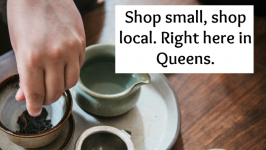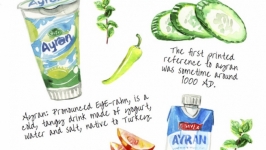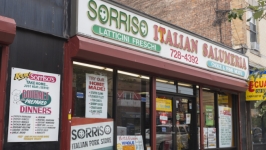Harry Rosenblum's Vinegar Revival Explores Recipes that Brighten Any Meal
Talk to any Bay Area septuagenarian or vegan college kid today and you’ll likely find that they’re tending to a Mason jar of bubbling sourdough starter or pickled farmers market vegetables. While people all around the world have been relying on food fermentation since ancient times—and natural fermentation predates human history—the practice has become particularly trendy in the past decade.
As is the case with all aspects of life, not all ferments get equal treatment. Kombucha, for example, has gained popularity over the past five or so years; the pungent, sticky strands of fermented soybeans known in Japanese as natto, on the other hand, have not been the subject of my PR emails about the hottest trends. And if you ask Harry Rosenblum, co-owner of the kitchen supply and grocery store Brooklyn Kitchen, he’ll argue that it’s time to revive a ferment that might not have the buzz or trendiness of others, but that is uniquely ubiquitous, nuanced and attention-worthy: vinegar.
“Even though we consume some form of vinegar every day [in the condiments, dressings and pickles we eat], vinegar by itself is still an underappreciated ingredient that can transform your cooking and your eating,” he writes in Vinegar Revival, his new cookbook from Clarkson Potter that argues the funky-tart liquid is the essential ingredient for enhancing your home cooking.
When I walk into Brooklyn Kitchen in Williamsburg to check out Rosenblum’s vinegar collection, my nose is hit with only the slightest scent of acetic acid, the component in vinegar that most people associate with the liquid’s smell and taste. Large stainless steel vats with spigots, labeled with “Red Wine Vinegar 6/30” and “Mish Mash Malt Vinegar 4/18/17” to signify type and date made, sit on shelves next to Mason jars of pickled cipollini onions, sweet and spicy green beans and even tiny containers of mothers, the collection of slippery cellulose that forms as a by-product of the bacteria converting alcohol into acetic acid.
“Kombucha has gotten the good marketing and all this mysticism around it, while vinegar was relegated to being a clear cleaning liquid,” Rosenblum tells me, and the more than 20 bottles in front of me disprove this alignment. The liquids range in color from sunflower yellow to deep brown; some are cloudy while others have strings of cellulose bobbing around the top; and the smells range from savory and reminiscent of soy sauce to sweet and malty, like a Bock beer. When I screw off the lid of Rosenblum’s melon vinegar and bring my nose close to the neck of the bottle, I’m hit with a scent of an overripe papaya. The flavor of it is just that: slightly sweet and musky, and something that I’d want to add to a glass of seltzer water or a gin shrub.
“My wife doesn’t like that one,” he jokes, though it’s my favorite of the other fruit vinegars he’s laid out: “apple scraps” and pineapple.
Rosenblum’s fascination with fermentation started in the mid-1990s when he found himself with a taste for alcohol but wasn’t yet old enough to buy himself a six-pack. While other underage kids were busy getting fake IDs that allowed them to order Long Island Iced Teas at their college bars, Rosenblum didn’t follow such a route. Proving his ability to delay gratification, he ordered packets of dry wine and champagne yeast, dumped them into gallons of apple cider from the Union Square Greenmarket, and got his buzz from homemade hard cider.
It was around 2005 when he started making vinegar, by combining some leftover hard cider with his basic knowledge of fermentation and a bottle of store-bought vinegar that had a mother in it. At its core, only three ingredients are needed to make vinegar— oxygen, alcohol and a mother, which is a rubbery colony of bacteria that turns alcohol into acetic acid —so when Rosenblum made his first concoction, he ended up with a jug of apple cider vinegar. More than a decade later, he’s fermented everything from Brooklyn Brewery’s lager beer to Fino sherry to pineapple skins and cores. He has yet to try out a version with chicha, the corn-based South and Central American beer, but that’s on his aspirational list.
Rosenblum argues that it’s very difficult to find good vinegars at your average grocery store that are nuanced and funky—one of the main reasons why he thinks people should be making vinegar themselves. “People don’t think about the flavor possibility of making your own,” he tells me, which is why he dedicates much of Vinegar Revival to detailed recipes.
For those who are in touch with their DIY spirits or have experience doting on a mother—either the colony of microorganisms or the woman who raised you—the vinegar-making process isn’t so intimidating. All you need to make a basic vinegar is your alcohol of choice, a mother and a supply of oxygen. For the first ingredient, Rosenblum suggests starting with something you enjoy drinking, whether that’s a malt beer or white wine or apple cider. That way, you’ll learn how the flavor changes as it ferments, and there’s a higher chance you’ll end up with something that you’ll use. Even if you find yourself with a barrel full of fruit flies or a liquid you don’t like, you likely didn’t lose much money or time in the process.
As Rosenblum repeatedly tells me, though, his goal isn’t to convince every single person who picks up his book to make room in their kitchen for a barrel. Therefore, the second half of Vinegar Revival focuses on recipes that either highlight specific types of vinegar or allow you to try out your favorite types of vinegar on looser recipes: Vinegar pie, steamed squash and fizzy cocktails are a few examples. And then maybe one day you’ll consider pouring hard cider and a mother into an oak barrel in your pantry.
“To the people who don’t love vinegar: You don’t have to make your own,” Rosenblum says. “I first want people to enjoy vinegar in more ways than they are. Then, perhaps, I can convince you to make it, so you get more of an interesting flavor.”
Harry’s Tips for Buying Vinegars and Bases in Queens
I make a trip to one of the H Marts in Flushing four or five times a year. I love shopping at the big Asian groceries because they have excellent vinegar selections. Vinegar is common in a lot of Asian cooking and you find good selections there.
Long Island City has great breweries and I’ve made vinegar from Rockaway Brewing beer and Fifth Hammer beer.
Vinegar Revival: Artisanal Recipes for Brightening Dishes and Drinks with Homemade Vinegars (Clarkson Potter, 2017)
Harry C Rosenblum | @thefoodballer
The Brooklyn Kitchen | @thebklynkitchen
Brooklyn Brewery | @brooklynbrewery
Union Square Greenmarket | @unsqgreenmarket
H Mart | @hmartusa
Fifth Hammer Brewing | @fifthhammerbeer
Rockaway Brewing Company | @rockawaybrewco












